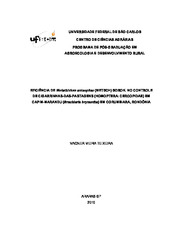| dc.contributor.author | Teixeira, Vagner Meira | |
| dc.date.accessioned | 2016-06-02T18:57:33Z | |
| dc.date.available | 2010-11-17 | |
| dc.date.available | 2016-06-02T18:57:33Z | |
| dc.date.issued | 2010-08-13 | |
| dc.identifier.citation | TEIXEIRA, Vagner Meira. Efficiency of Metarhizium anisopliae (Metsch) Sorokin for the control of spittlebug (Homoptera: Cercopidae) of Brachiaria Bryzantha pasture in Corumbiara region, Rondonia state. 2010. 71 f. Dissertação (Mestrado em Ciências Agrárias) - Universidade Federal de São Carlos, Araras, 2010. | por |
| dc.identifier.uri | https://repositorio.ufscar.br/handle/ufscar/96 | |
| dc.description.abstract | Spittlebugs are the main pests of pasture of America Tropical, among which the genera Deois and Mahanarva stand out. These pests have been causing serious losses in the Brachiaria bryzantha pasture of the Rondônia State, Brazil. The fungus entomopathogenic Metarhizium anisopliae (Metsch.) Sorokin is considered an efficient agent for the biological control of many insects that represent plagues of agriculture. The objective of this research was to evaluate the efficiency of spraying Brachiaria bryzantha pasture with the fungus M. anisopliae (isolate ESALQ 1037) against naturally infestation with the cattle tick spittlebug nymphs was evaluated. In this work the efficacy the fungus of applied at in twice formulations (concentrated emulsifiable oil and wettable powder), trhee doses (1,0 x109, 1,5 x109, 2 x109 viable conidias ha-1) in once for twice during the pest infested with period. The study was conducted from December 2008 to February 2009 at the Daiane farm in Corumbiara, Rondônia State, Brazil. The fungus was applied from 05 pm, under average temperature of 18 ºC and relative air humidity of 69%. The volume of the solution utilized was 300 liter ha-1 with sprayer. The evaluations were performed at the beginning (day 0), and 15, 32, 45, 61 e and 75 days, being one evaluation before the applications, and five after the applications of this fungus, counting the spittlebugs (nymphs) per 0.0625 m² (0.25 m x 0.25 m square). At 0 days the infestation was of 153,6 nymphs/m². It was verified that the levels of nymphs were reduced after the sprayings of M. anisopliae in all treatments. The stinkbug in efficiency control levels were higher of spittlebug nymphs for aplication fungus isolate, between 85,30% to 93,72%, in 75 days the applications, of this fungus. From these data, we conclude that M. anisopliae isolate ESALQ 1037 was efficient to control spittlebug in the B. bryzantha pasture, thus being a promising choice for use as a microbial insecticide and thus being promising choice familiar agriculture integrated pest management of in the Rondônia State | eng |
| dc.format | application/pdf | por |
| dc.language | por | por |
| dc.publisher | Universidade Federal de São Carlos | por |
| dc.rights | Acesso Aberto | por |
| dc.subject | Controle biológico | por |
| dc.subject | Cigarrinha das pastagens | por |
| dc.subject | Inseto - controle microbiano | por |
| dc.subject | Pragas agrícolas - manejo integrado | por |
| dc.subject | Spittlebug | eng |
| dc.subject | Biological control | eng |
| dc.subject | Microbial control | eng |
| dc.subject | Integrated pest management | eng |
| dc.title | Eficiência de Metarhizium anisopliae (Metsch) Sorok. no
controle de cigarrinhas-das-pastagens (Homoptera: Cercopidae) em capim-marandu (Brachiaria bryzantha) em
Corumbiara, Rondônia | por |
| dc.title.alternative | Efficiency of Metarhizium anisopliae (Metsch) Sorokin for the control of spittlebug (Homoptera: Cercopidae) of Brachiaria Bryzantha pasture in Corumbiara region, Rondonia state | eng |
| dc.type | Dissertação | por |
| dc.contributor.advisor1 | Sá, Luiz Alexandre Nogueira de | |
| dc.contributor.advisor1Lattes | http://lattes.cnpq.br/0985007035212882 | por |
| dc.description.resumo | As cigarrinhas-das-pastagens constituem as principais pragas de gramíneas forrageiras em toda a América Tropical, destacando-se os gêneros Deois e Mahanarva. Essas pragas vêm causando sérios danos a Brachiaria bryzantha cv. Marandu no Estado de Rondônia. O fungo entomopatogênico Metarhizium anisopliae (Metsch.) Sorokin é considerado um eficiente agente para o controle biológico de grande número de insetos-pragas, como cigarrinha da cana-deaçúcar e das pastagens. O objetivo desta pesquisa foi avaliar a eficiência da aplicação de Metarhizium anisopliae (isolado ESALQ 1037) no controle da infestação de cigarrinhas-das-pastagens em capim-Marandu (B. bryzantha) submetida ao pastejo com bovinos. Avaliou-se o efeito do fungo aplicado em duas formulações, três dosagens e duas épocas ao longo do período de infestação da praga. As dosagens aplicadas foram de 1,0 x109, 1,5 x109, 2,0 x109 conídios viáveis/ha, nas formulações de concentrado emulsionável e Pó molhável. O estudo foi conduzido no Sítio Daiane, município de Corumbiara, RO, no período de dezembro de 2007 a fevereiro de 2008. O isolado foi aplicado a partir das 17h, sob temperatura média de 18° C e umidade relativa de 69%. O volume de calda foi de 300 L/ha, utilizando-se pulverizador costal manual. As avaliações procederam-se aos 0, 15, 32, 45, 61 e 75 dias, contando-se as cigarrinhas (ninfas) por ponto de 0,0625 m² (quadrado de 0,25 m x 0,25 m). Aos 0 dias a infestação era de 153,6 ninfas/ m². Foi observada a diminuição das ninfas das cigarrinhas-das-pastagens em todos os tratamentos com a aplicação do fungo M. anisopliae. Os níveis de eficiência de controle das ninfas das cigarrinhas com a aplicação do Metarril® variaram de 85,30% e 93,72%, aos 75 dias. Com base nos resultados obtidos, conclui-se que M. anisopliae (isolado ESALQ 1037) é eficiente para o controle das cigarrinhaspastagens em capim-Marandu (B. bryzantha), constituindo-se em uma alternativa promissora para ser utilizado como inseticida microbiano em programas de manejo integrado de pragas para o Estado de Rondônia. | por |
| dc.publisher.country | BR | por |
| dc.publisher.initials | UFSCar | por |
| dc.publisher.program | Programa de Pós-Graduação em Agroecologia e Desenvolvimento Rural - PPGADR-Ar | por |
| dc.subject.cnpq | CIENCIAS AGRARIAS | por |
| dc.contributor.authorlattes | http://lattes.cnpq.br/2676352999249733 | por |
